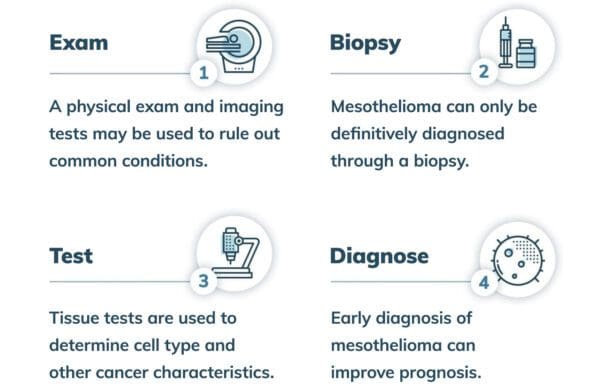01. Diagnosing Mesothelioma
How Is Mesothelioma Diagnosed?
Diagnosing mesothelioma usually includes multiple tests. The process often begins when a patient shows symptoms of mesothelioma. However, many mesothelioma symptoms resemble those of other conditions, so they may be misdiagnosed. Patients should advocate for themselves if they feel that something may be wrong and they are aware of past asbestos exposure. It is critical for the patient to mention any past asbestos exposure to help the doctor with the diagnosis.
A simple way to think about it is to break up the diagnosis into two phases:
- Phase 1: The first phase of diagnosis includes general exams and tests.
- Phase 2: The second phase of diagnosis includes specific tests for mesothelioma and cancer.
In the first phase, patients discuss their full medical history with their doctor. This helps the doctor get information that can narrow down the possibilities. When discussing medical history, the patient has an opportunity to mention asbestos exposure. The doctor may then conduct a physical exam to check for any lumps or abnormalities. They may then conduct basic imaging tests, like an X-ray, and blood work. Doctors use basic blood to check a patient’s overall health and organ function. This may also help rule out other conditions.
The second phase involves more advanced diagnostic procedures. The doctor might request specific blood tests or advanced imaging scans if they suspect mesothelioma. Imaging scans may include:
- Computed tomography (CT)
- Echocardiogram
- Magnetic resonance imaging (MRI)
- Positron emission tomography (PET)
Next, the doctor may order a biopsy, which is a procedure to remove a sample of the suspicious tissue or fluid. There are many ways a doctor might perform a biopsy, and the method depends on the patient’s case. A pathology laboratory tests the tissue and fluid samples to learn more about the cancerous cells. Doctors use the test results to determine cell type and other cancer characteristics.
02. Testing for Mesothelioma
How Do Doctors Test for Mesothelioma?
Doctors generally use several tests to find out the cause of their patients’ symptoms. Some common tests include blood tests and imaging scans. Blood tests help doctors find biomarkers that may suggest mesothelioma or another cancer. Imaging scans can show tumors and help the doctor find any cancer spread. These tests may help the doctor diagnose the patient, but biopsies are the only way to confirm a patient has mesothelioma.
Imaging Scans
Different imaging tests help doctors identify tumors, their location and metastasis of cancer. Doctors may use X-rays, MRIs, CT scans, PET scans or ultrasounds when diagnosing mesothelioma.
- X-rays: X-rays identify abnormalities and help rule out other conditions. Doctors may use an X-ray to reveal common mesothelioma symptoms. These symptoms may include pleural effusions or peritoneal effusions.
- CT scans: CT scans take a series of X-rays to make a detailed, three-dimensional image of the body. CT scans are an important tool in the diagnosis of all types of mesothelioma.
- MRI scans: MRIs create intricate images of bones and soft tissue. MRIs can detect the spreading of mesothelioma into nearby or distant tissues. Doctors also may use the scan as part of the staging process.
- PET scans: PET scans visualize areas of quickly dividing cells, including tumors. This helps distinguish between normal and cancerous tissue. These scans are helpful in showing metastasis.
Biopsies
Biopsies are the only way to confirm a mesothelioma diagnosis. These tests involve removing a sample of fluid or tissue for analysis. By testing this tissue, doctors confirm the diagnosis, stage, cell type and type of mesothelioma. Once the diagnosis is confirmed through a biopsy, a medical team can begin to determine treatment options.
There are four types of biopsies commonly used for mesothelioma diagnosis:
- Fluid drainage: Fluid drainage is the least invasive biopsy option. This procedure collects fluid from pleural, peritoneal or pericardial effusions using a needle or catheter. Doctors may drain the fluid sample through thoracentesis, an outpatient procedure. But, in most instances, a fluid sample is not adequate to confirm a mesothelioma diagnosis.
- Needle biopsies: Doctors use a needle biopsy to extract a tissue sample from an affected area. In suspected cases of pleural mesothelioma, the tissue samples may be taken from the pleura (lining of the lung) or a lymph node.
- Surgical biopsies: Surgical biopsies are the most invasive biopsy procedure. Doctors may use this biopsy when mesothelioma tumors are difficult to reach. Surgical biopsies used for mesothelioma include thoracotomy and laparotomy.
- Surgical camera-assisted biopsies: These biopsies start with a small incision. Then, the doctor places a tube and passes a small camera through it into the affected area. Doctors can then locate and retrieve any suspicious looking tissue for analysis. Types of camera-assisted biopsies used for mesothelioma include thoracoscopy, laparoscopy and mediastinoscopy.
Blood and Tissue Tests
A mesothelioma doctor may use blood tests to check overall patient health and to find specific markers that suggest cancer. Doctors generally use tissue tests to make a diagnosis.
Blood tests alone cannot diagnose mesothelioma, but they may guide the doctor towards a diagnosis. For example, the complete blood count (CBC) can identify changes in blood cell and platelet levels. More advanced tests can find specific markers that point to a mesothelioma diagnosis.
The only way a doctor can confirm a mesothelioma diagnosis is to examine cells from the abnormal area. The doctor collects these tissues during a biopsy and sends them to a lab where they are examined. Specialists then test the samples to determine which types of cells they contain.
If the tests find properties consistent with mesothelioma, then the abnormal tissue may be diagnosed as mesothelioma. If the tests find properties that do not match mesothelioma cells, then the abnormal tissue may be diagnosed as a different condition.
How Does Pathology Help Diagnose Mesothelioma?
Pathology is the study of how a disease develops and affects a person. Pathology testing can identify and conclusively diagnose mesothelioma. Mesothelioma pathology includes two types of testing: histology and cytology.
Cytology studies individual cells and their identifying characteristics. Histology focuses on mesothelioma tissue and its effects on the tissues around it.
Doctors use pathology testing to confirm a mesothelioma diagnosis. Patients can help doctors order the right tests by sharing any known history of asbestos exposure. This may speed up the diagnostic process and help ensure timely treatment.
Mesothelioma patient and survivor Heather Von St. James recounts her reaction when learning about her mesothelioma diagnosis from her doctor.
03. Screening for Mesothelioma
Does Screening Help Detect Mesothelioma Early?
There is no officially recognized test to detect mesothelioma early. However, researchers continue to study possible early detection methods. Anyone who has past exposure to asbestos may want to speak to their doctor about routine monitoring. Some people who work in at-risk occupations for asbestos exposure may have mandatory screenings. These screenings may include:
- Chest X-rays
- Pulmonary function tests
- Specific physician-ordered lab tests
It may take decades for mesothelioma symptoms to show up because it has a long latency period. Monitoring may help doctors detect signs of the disease earlier, and early diagnosis and treatment may improve patient outcomes.
For example, patients diagnosed with stage 1 or stage 2 mesothelioma may be able to have a multimodal treatment that includes a more aggressive surgery. These treatments have shown success in extending survival and life expectancy. Those diagnosed at stage 3 or stage 4 mesothelioma commonly undergo similar treatment. But the treatment may leave behind more cancer cells because of the larger amount of cancer. Still, even patients with advanced mesothelioma have a more favorable prognosis with treatment.
Resources for Mesothelioma Patients
04. Mesothelioma Misdiagnosis
Why Is It Hard to Get an Accurate Mesothelioma Diagnosis?
Doctors may have trouble accurately diagnosing mesothelioma for many reasons. In part, trouble with diagnosis comes from the disease’s non-specific symptoms. For example, symptoms common with pleural mesothelioma include a dry cough and shortness of breath. These symptoms are also similar to the flu or pneumonia.
Another reason is that mesothelioma is a rare form of cancer. Only about 3,000 new cases are diagnosed in the United States each year. Because there are so few cases each year, not many doctors have experience diagnosing and treating it.
The potential to misdiagnose mesothelioma makes it even more important for the patient to mention if they have past asbestos exposure. This exposure is the biggest risk factor to developing mesothelioma.
Easily Mistaken Symptoms
Mesothelioma symptoms can resemble other common conditions. Mesothelioma patients often have a cough, difficulty breathing and fatigue. They may also experience loss of appetite, pain and nausea. Several common conditions share one or more of these symptoms, including the flu, pneumonia, Crohn’s disease and irritable bowel syndrome.
Because mesothelioma has similar symptoms to other illnesses, patients may confuse it with other conditions.
Patients can help doctors find the cause of their symptoms by telling them they were exposed to asbestos This information can help healthcare providers order the right diagnostic tests. It can also help ensure timely diagnosis and treatment.
Patients May Forget Risk Factors
Mesothelioma can take a long time to develop, which can impact diagnosis. After asbestos exposure, patients may live 10 to 50 years before having symptoms. This time period is mesothelioma’s latency period.
With such a lengthy time between exposure and symptoms showing, the patient may forget past asbestos exposure. As a result, doctors and patients may assume the symptoms come from other illnesses. This can extend the time it takes a patient to get an accurate mesothelioma diagnosis.
Mesothelioma Experts Are Rare
Mesothelioma is rare in the United States, with roughly 3,000 new cases per year. In comparison, the total number of cancer cases in the United States was more than 1.7 million in 2019. Because the disease is so rare, it is hard to find a doctor with experience treating it.
Doctors and pathologists inexperienced with mesothelioma may have difficulty recognizing the disease, even with the right types of tests. Some guidelines even recommend that someone who has worked with mesothelioma should conduct the diagnosis. But because experts are rare, patients may not have easy access to them. For some patients, it may take longer to arrive at the correct diagnosis.
Staging to Estimate the Extent of Cancer
Part of diagnosis may include estimating the extent of cancer. Doctors refer to this as staging the patient’s mesothelioma. This information helps doctors create the best treatment plan.
In some cases, mesothelioma staging may be difficult. Some tests may not provide accurate information because of a tumor’s location or shape. If the staging does prove difficult, the doctor may order additional tests before proceeding to treatment.
Common Mesothelioma Misdiagnoses
All types of mesothelioma have been misdiagnosed. Two factors contribute to this. First, mesothelioma is rare, as are specialists with experience diagnosing it. Second, mesothelioma shares symptoms with several other conditions. This can make it easy for a doctor to mistake mesothelioma for a more common illness.
05. Next Steps After Diagnosis
Getting the Best Treatment After a Mesothelioma Diagnosis
Mesothelioma patients have an array of treatment options. Several have already helped some patients outlive their original prognosis. To help ensure the most effective treatment, patients should seek out a mesothelioma expert to confirm their diagnosis. Specialists at an experienced cancer center may be able to provide more accurate staging and better treatment options.
Fortunately, research has expanded treatment options in recent years. As more studies take place, more treatment options may become available. Some promising treatment options include multimodal treatments that combine surgery and chemo.
Checkpoint inhibitor drugs Opdivo® (nivolumab) and Yervoy® (ipilimumab) have more than doubled survival for some patients. Plus, advancements in chemotherapy, such as HIPEC and HITHOC, have also helped many patients. Patients who seek treatment at experienced cancer centers may have easier access to these and other therapies.
06. Common Questions
Common Questions About Mesothelioma Diagnosis
-
How difficult is it to diagnose mesothelioma?
- Mesothelioma can be difficult to diagnose because of its nonspecific symptoms, which means the symptoms may resemble other conditions. But patients can provide information to help healthcare providers find the right diagnosis. Individuals with a history of asbestos exposure can share that history with their doctors. This can make it easier for the doctor to order the right tests to confirm or rule out mesothelioma.
-
How long does it take to diagnose mesothelioma?
- Many factors can affect the length of time to diagnose mesothelioma, including the location and cell type. In general, a mesothelioma diagnosis takes two to six months.
-
How early can mesothelioma be detected?
- Doctors have diagnosed mesothelioma before it became a significant problem for some patients. In one recorded case, doctors diagnosed mesothelioma so early that the cancerous tissue was a single layer of abnormal cells. It is very rare to diagnose mesothelioma that early because it may not be causing symptoms. This early phase of the disease is called mesothelioma in situ, and data suggests it may occur seven years before the tumor causes symptoms.
-
What is the most accurate way to diagnose mesothelioma?
- The only way to confirm a mesothelioma diagnosis is by testing a biopsy tissue sample. Doctors may run other tests to rule out different conditions. But those other tests cannot diagnose mesothelioma.
-
What should I do if I think I was misdiagnosed?
- Anyone who believes they may have been misdiagnosed should get a second opinion. Top cancer centers may be better able to provide an accurate second-opinion than local hospitals. These cancer centers may have additional diagnostic resources and experts familiar with mesothelioma.












